

This essay attempts to explain some of that fantastic lost technology and why it was lost to history many centuries ago. It also endeavors to reveal the real science behind some of the most important treasure items from the lost age of Atlantis that are found in Western Mythology.
One of the most remarkable tools from the lost age of Atlantis included a remarkable method of generating and focusing electro-chemical energy that could "score" through wood and stone -- much like a powerful modern laser device.
However, unlike a modern laser device that uses photonic energy within a narrow beam to burn through materials, this fantastic lost technology was based on a concept of using the power of electro-chemical activity from certain elements that were capable of "gyromagnetic and piezeoelectric" energy, which -- when shaped and focused by a parabolic lens of platinum, could create a unique "particle-beam" event along a path some distance from the point source. This unique "particle-beam" event could be used to cut or burn through other materials along its path -- including the atmosphere between the source and the target.
Almost just like the flaming sword in the movie "Star Wars", this "light saber" tool design from another age could have been used to cut down whole forest or carve the seaport city of Atlantis out of a stony hill in what is now a jungle lake area in Central America.
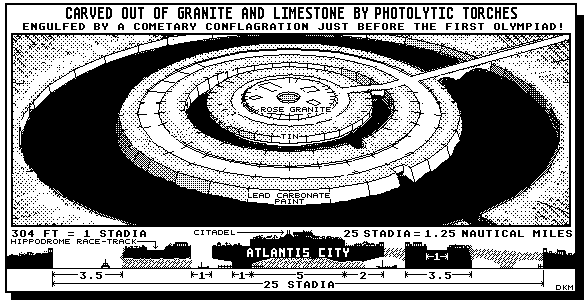
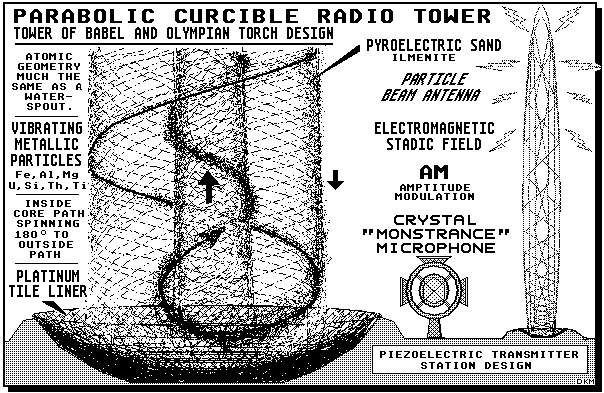
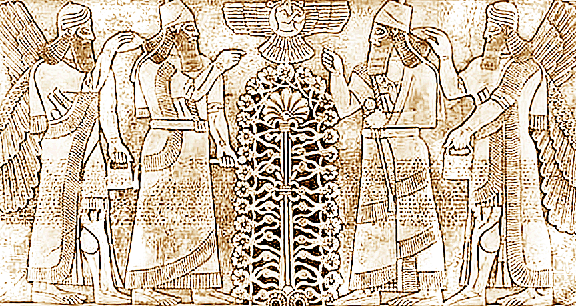
But before we study the details of how this lost fantastic technology was used to send and recieve wireless radio signals in antediluvian times, let us first understand what is "partical-beam" technology.
Images of some alchemist peering over some boiling pot down in the castle basement comes to mind when studying this lost technology.
However, perhaps this elusive powerful substance was, in reality, a chemical reaction that resulted in a very hot and caustic plasmatic beam of iron filaments and carbonic crystals capable of scoring through most anything in its path.
What makes the beam zone get in focus is a parabolic lens made from an elemental substance capable of withstanding very hot temperatures -- and only the platinum base elements could do the job.
What makes the beam zone stay in focus is the "gyromagnetic and piezeoelectric" energy within the beam.
One story about the Holy Grail was based on a cryptic Welsh poem about a "magic cauldron" capable of creating light. Perhaps the story about "the old cooking pot at the end of the rainbow" is based on this "magic cauldron" story.
How this story got tangled up with the Christian tale of the Holy Grail could be because both magical "bowls" or "cups" are the same parabolic lens design that the alchemist needed to perform the trick of creating a bright beam of light.
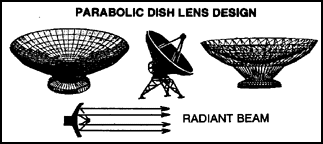
Add to this incendiary flash-powder mixture some iron and aluminum powders -- which equals the elemental make up of a powerful substance known as "thermite", together with other materials such as Ilmenite and animal blood plasma as a flux that contains some carbonic crystals, and you should have a very powerful device for cutting things.
This lost electromagnetic "sand-blaster" technology was probably misused by certain characters from ancient times. One such Assyrian king named "Nimrod" could have built a very large version of this magic lamp design and may have caused a catastrophic accident when the bottom of his "Tower of Babel" blew-out -- causing the "bottomless pit" story as documented in the Holy Bible.
Whatever has been written about the "Tower of Babel", the very idea that Nimrod's tower from Biblical times was some sort of electromagnetic "radio tower" is indeed a radical concept. After all, according to conventional history, radio communication is only about a hundred and twenty years old -- isn't it? Perhaps not.
Imagine if the transportable "Ark of the Covenant" within the "Tabernacle Tent" was also a "pillar of fire" device -- or "foldable spire" beam, that was capable of creating a static-field column of energy which could transmit wireless AM signals over great distances. Was the "burning bush" that Moses talked to and recieved comandments, in reality, a static-field radio transmitter?
Imagine if crude crystal radio communication technology once existed in Biblical times. If it did, why does conventional ancient history never mention it? Maybe it does -- its just that one has to know how to read certain entries from ancient literature and understand the technical possibilities of such a science.
While ancient transmitter technology may seem amazing to believe, the crystal receivers once used by our Atlantean ancestors were also amazing. Made from simple quartz crystals and some coiled copper wire, these little "head sets" needed only the AM power in the signal to power the receiver by way of the "royal crown" antenna.
Other versions of these prehistoric crystal receiver devices -- once used by certain Atlantean "diplomats", would also rely on a special "handbag" item -- which may have been a battery or capacitor to power the portable wireless radio receiver system. Connected to a hand held directional antenna -- shaped like a pine-cone -- or "crown" device via the skin, the pulse system would send the signals to "vibrate" wearable "jewelry" that the diplomat wore. The "jewelry" looked like "wrist watches" or large "earrings" that contained a small diaphragm similar to modern speakers.
In other words, the power from the "handbag" battery was needed to electrically amplify the weak electric signals from the antenna receiver that received wireless binary coded messages from "plasma pillar transmitters" operated by other members of "the tribe". Perhaps the "handbag" was just a small bag that contained the "radio items" when not in use.
The prehistoric coded language used in this antediluvian radio technology was Ogam.
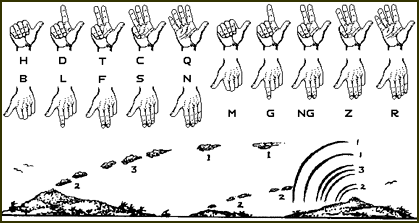
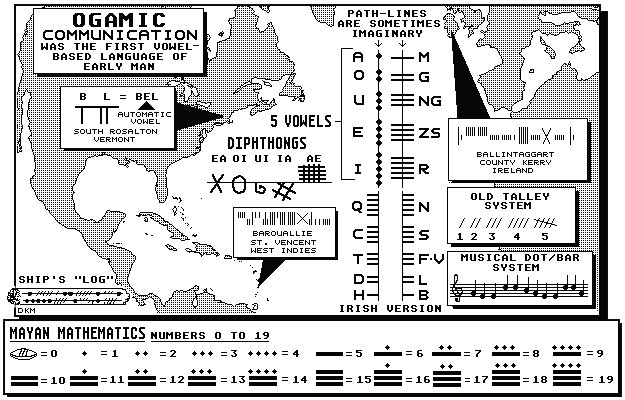
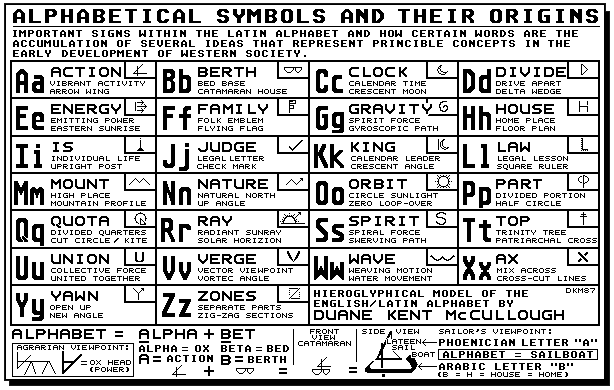
Our Atlantean ancestors were also in possession of a lost aeronautical technology wherein a simple sail-wing kite design evolved into a glider aircraft design that may have been propelled by some kind of gyroscopic-motor propulsion system.
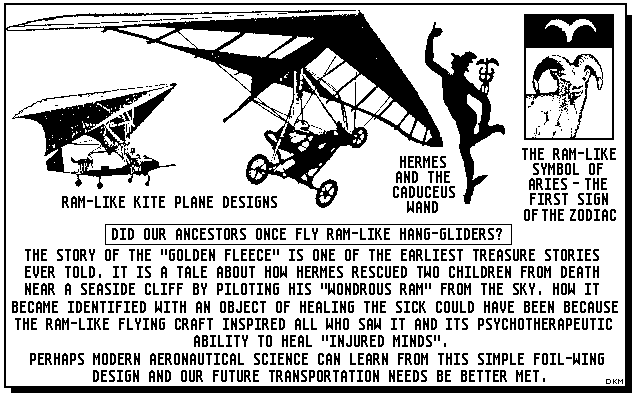
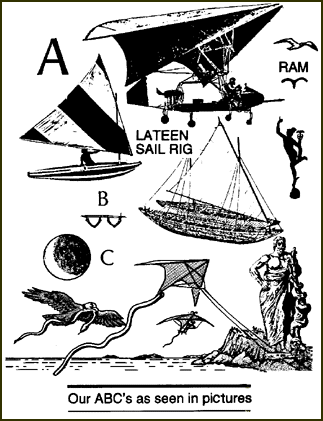
Watch any modern deltoid stunt kite with its spiraling tail, and imagine the healing effect upon some people who are amazed as to how it works. Good entertainment can heal the mind.
Perhaps the famous shaman of Middle America known as Quetzalcoatl was a scholastic survivor from the Atlantean age.
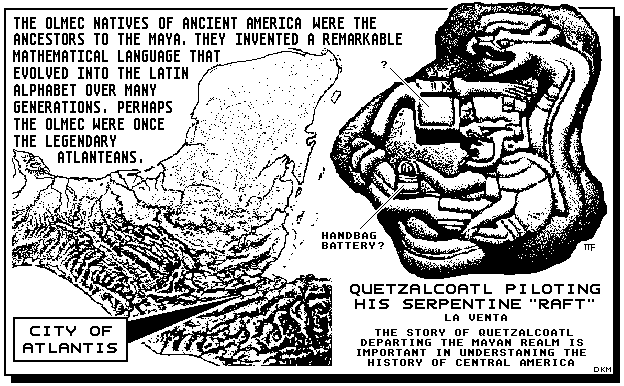

Speaking of ancient flying machines, in the Mayan city of Palenque in the Yucatan lies a sarcophagus lid that portrays a pilot operating some kind of boiler device. Imagine if steam pressure power was once used to drive a vertical shaft attached to several "particle-beam" blades of an ancient aircraft design. Gyroscopic "wheels within wheels" on this "flying platform" would allow for stability and could also be powered by steam pressure.
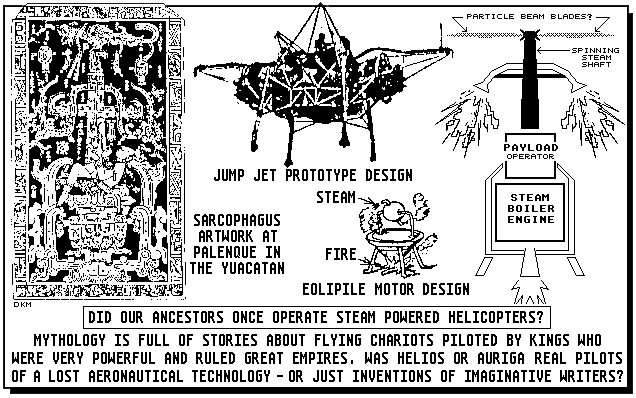
Perhaps the pilot -- who operated this magnificant steam powered flying machine, was just patrolling the area where Ezekiel was and stopped by the river to get water for his aircraft.
If such a steam-powered helicopter-like aircraft did exist in Biblical times, its range was probably very limited because the need for water to power the steam motor -- and the weight of water the aircraft could carry -- not to mention the weight of the metal used housing the boiler and needed piping to direct the steam, were factors that would restrict operations.
Ezekiel also describe God's winged charriot as having "hundreds of eyes" -- which may have been "rivets" that held the metal sections together -- and were painted as eyes for decoration reasons.
As mentioned earlier, what made this apparently heavy aircraft fly were the powerful "particle-beam blades" or "props" mounted on the top of the aircraft that were attached to a spinning vertical shaft -- which was spinning because of the escaping steam from directional nozzels placed near the top of the machine.
And again as mentioned -- steam pressure from the boiler would also power the four "wheels within wheels" -- or four gyros, to stablize the aircraft.
Plato also describes a "winged chariot" that stood within the main acropolis temple -- or "hanger building", at the center of the city of Atlantis. Did Plato and Ezekiel describe the same type of helicopter aircraft from long ago?
Did the ancient mythical gods Helios and Auriga pilot such highly decorated steam-powered helicopters or "quadcopters" of yesteryear? If they did, then perhaps conventional history needs some serious "updating".
Why this extraordinary technology was lost to the world can be explained by understanding the astrophysical forces of how a rogue comet could have caused the end of the Atlantean age.
Comets have and continue to collide with the planets in our solar system -- but what if a large one hit the Sun. Comets are attracted to the Sun -- and it is a bigger target than any planet. In fact, in 1976, Comet West broke up and crashed into the Sun -- possibly causing some kind of solar flair event or "electromagnetic splash" incident on the Sun that may have affected life back here on earth.
In 1976, fifteen major earthquakes struck around the world -- one in China wherein more than 600,000 were killed. Disaster also hit Guatemala earlier that year where over 23,000 were killed in the earthquake event. The epicenter of the 7.2 earthquake was less than ten miles from the Atlantis seaport site at the bottom of Lake Izabal on a major fault line that runs through Central America.
The very word "disaster" comes from the phrase "the aster" -- as in "the star" or astroid/comet that may have caused the destruction of Atlantis.
So, perhaps the lost technology from the antediluvian age of Atlantis will be rediscovered by other modern scientist and help make our world more efficient in building a better place -- hopefully before the next "bath" from space may take it all away again.